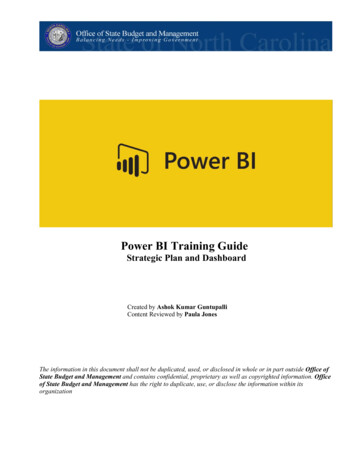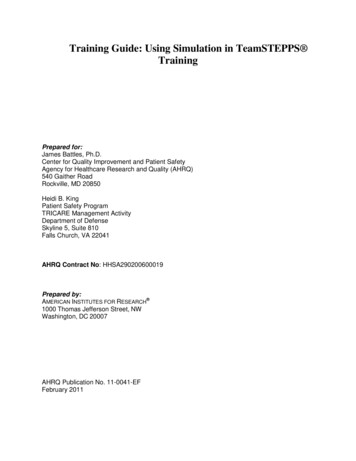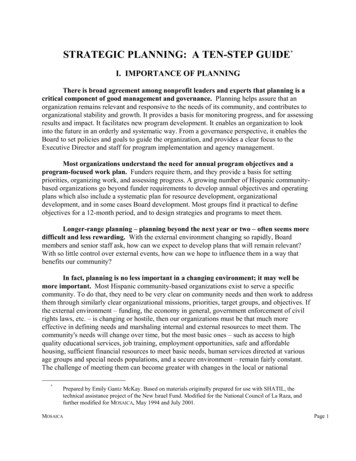
Transcription
Power BI Training GuideStrategic Plan and DashboardCreated by Ashok Kumar GuntupalliContent Reviewed by Paula JonesThe information in this document shall not be duplicated, used, or disclosed in whole or in part outside Office ofState Budget and Management and contains confidential, proprietary as well as copyrighted information. Officeof State Budget and Management has the right to duplicate, use, or disclose the information within itsorganization
ContentsIntroducing Power BI . 3Parts of Power BI . 3The flow of work in Power BI. 4Power BI Desktop: . 4Power BI Desktop Interface: The Report has five main areas: . 5Querying Data from CSV . 6Query Editor . 6Exercise 1: Get Started with Query Editor . 6Exercise 2: Connecting the data from the Excel Source . 7Interface of Query Editor . 9Exercise 3: Clean, Transform the data (Removing Nulls) . 11Calculated Measures Using DAX . 13Exercise 4: Creating of the Measures using DAX . 13Exercise 5: Change the format of the Measures . 14Creating Reports & Visualizations . 15Exercise 6: Creating your first visualization (Completion % of All Goals) Gauge Chart . 15Exercise 7: Importing a Theme to a Power BI Desktop File. 16Exercise 8: Changing the Color of the Gauge. . 17Exercise 9: Changing the Title of the Gauge Chart. 18Exercise 9: Creating the Stacked Column Chart. . 19Exercise 10: Sorting the Goals in the right order. . 20Exercise 10: Filters in Power BI. 22Page 2 of 29
Introducing Power BIPower BI is a suite of business analytics tools which connects to different data sources to analyze data and shareinsights throughout your organization.Parts of Power BIThere are 3 Parts of Power BI.1. Power BI Desktop2. Power BI Service3. Power BI MobilePower BI Desktop: It is a Windows desktop application (Report Authoring Tool) which Lets you build queries,models and reports that visualize data.Power BI Service: Power BI Service is cloud based Software as Service Application which allows us to createdashboards, Setup schedule data refreshes, Share the reports securely in the organization.Power BI Mobile: It is an application (App) on mobile devices which allows you to interact with the reports anddashboard from Power BI Service.Page 3 of 29
The flow of work in Power BIA common flow of work in Power BI begins in Power BI Desktop, where a report is created. That report is thenpublished to the Power BI service, and then shared so users of Power BI Mobile apps can consume theinformation.It doesn’t always happen that way, and that’s okay, but we’ll use that flow to help you learn the various parts ofPower BI, and how they complement one another.Power BI Desktop:Power BI Desktop is report authoring tool that allows you to create reports, queries, Extract Transform and Loadthe data from data sources and model the queries.Page 4 of 29
Power BI Desktop Interface: The Report has five main areas:1. Ribbon: The Ribbon displays common tasks associated with reports and visualizations;2. Pages: The Pages tab area along the bottom allows you to select or add a report page;3. Visualizations: The Visualizations pane allows you to change visualizations, customize colors or axes,apply filters, drag fields, and more;4. Fields: The Fields pane, allows you to drag and drop query elements and filters onto the Report view, ordrag to the Filters area of the Visualizations pane;5. Views Pane: There are three types of views in the views pane Reports View – allows you to create any number of report pages with visualizations. Data View – allows you to inspect, explore, and understand data in your Power BI Desktop model. Relationship or Model view – allows you to show all of the tables, columns, and relationships in yourmodel.Page 5 of 29
Querying Data from CSVQuery EditorYou can import and clean data from Oracle while working in Power BI.Query Editor, allows you to connect to one or many data sources, shape and transform the data to meet yourbusiness needs, then load the queries into the model into Power BI DesktopThis below step provides an overview of the work with data as well as connecting to data sources, shaping thedata in Query EditorExercise 1: Get Started with Query Editor1. To get to Query Editor, select Edit Queries from the Home tab of Power BI Desktop.2. Click on the drop down of the Edit Queries on the bottom right corner, click on Edit QueriesPage 6 of 29
Note: With no data connections, Query Editor appears as a blank pane, ready for data.Below image shows the interface of the Query EditorExercise 2: Connecting the data from the Excel Source3. From Home tab New Source Choose ExcelPage 7 of 29
4. Navigate to the Strategic Plan and Dashboard Folder and ChoosePowerBITraining StrategicPlanDashboard Input Template Excel File5. Click on Open () at the bottom of the screenYou can see a navigator screen to select the sheets on the Excel Workbook. In our case, we have one sheet namedas InputPage 8 of 29
6. Select Input sheet from the available list7. Click OK ()at the bottom of the screenInterface of Query EditorQuery Editor consists of 4 Parts1. Query Ribbon2. Left Pane3. Center (Data) Pane4. Query SettingsPage 9 of 29
The Query RibbonThe Ribbon in Query Editor consists of four tabs HomeTransformAdd ColumnViewHome Tab: The Home tab contains the common query tasks, including the first step in any query, which is GetData.Transform: The Transform tab provides access to common data transformation tasks, such as adding orremoving columns, changing data types, splitting columns, and other data-driven tasks.Add Column: The Add Column tab provides additional tasks associated with adding a column, formattingcolumn data, and adding custom columns. The following image shows the Add Column tab.View Tab: The View tab on the ribbon is used to toggle whether certain panes or windows are displayed. It’s alsoused to display the Advanced Editor. The following image shows the View tab.The Left pane:The left pane displays the number of active queries, as well as the name of the query. When you select aquery from the left pane, its data is displayed in the center pane, where you can shape and transform thedata to meet your needs.Page 10 of 29
The center (data) pane:In the Center pane, or Data pane, data from the selected query is displayed. This is where much of the work ofthe Query view is accomplished.The Query settings pane:The Query Settings pane is where all steps associated with a query are displayed.Exercise 3: Clean, Transform the data (Removing Nulls)Removing the unwanted rows in the query.8. Home Tab Reduce Rows section Remove Rows Remove Blank RowsNotice that null records are eliminated, and new steps is added for the transformation you applied to the query inthe query settings pane of the selected query.Page 11 of 29
Note: Each step, you do in the Query Editor is recorded in Applied Steps of Query Settings pane.9. From Home Ribbon Click on Close & ApplyNote: After Close & Apply the query is added to the model for report development.Page 12 of 29
Calculated Measures Using DAXIn general, Measures are used to calculate aggregates, such as the sum or average of a column. Measures arecalculated at the time of your query, which means that they aren't stored in your database, but useprocessing power to execute a query at the time of your request.Exercise 4: Creating of the Measures using DAX10. Be on the Report view, From the Fields Pane, click on the Ellipses (More options) of the Input Query, Clickon New Measure.11. In the Expression Bar, Type inOverall Completion% sum (Input [Completion%]) /(COUNTROWS(Input)*100)12. Click on Commit to validate the ExpressionPage 13 of 29
Note: After you commit, if there are any errors in the expression, the expression will be highlighted withred curly line.Exercise 5: Change the format of the Measures13. Expand Input query under Fields pane, Select Overall Completion %, and from the Modeling ribbon, Click onthe Format under the formatting section and select Percentage.14. Make the decimal points to Zero of the Overall Completion % measure under formatting section.Page 14 of 29
Creating Reports & VisualizationsExercise 6: Creating your first visualization (Completion % of All Goals) Gauge Chart15. Click on Visualizations Pane and Click on Gauge ChartNote: Make sure the Visualization is selected before dropping the fields.16. Expand Input Query, Drag Overall Completion% to the Value section of the Fields pane of the gauge VisualPage 15 of 29
Exercise 7: Importing a Theme to a Power BI Desktop File.With Report Themes you can apply design changes to your entire report, such as using corporate colors,changing icon sets, or applying new default visual formatting. When you apply a Report Theme, all visuals inyour report use the colors and formatting from your selected theme.17. From the Home Ribbon of the Report view, click on the drop down of the Switch Theme under Themessection and select Import from the file. Drag Overall Completion% to the Value section of the Fields pane ofthe gauge VisualA window appears that lets you browse to the location of the JSON theme file18. Navigate to the Strategic Plan and Dashboard folder o the Desktop and select Power BI Color Theme.Json filePage 16 of 29
19. Click on Open () at the bottom of the screenYou will get a success message once the theme is imported successfully.Exercise 8: Changing the Color of the Gauge.20. Select the Gauge Chart and Click on the Formatof the Gauge Chart, Expand Data Colors properties,click on the drop down of Fill property and select light blue colorAfter the changing the color the gauge chart looks like the one below.Page 17 of 29
21. Click on the drop down of Target property and select Black color.Exercise 9: Changing the Title of the Gauge Chart.22. Expand the title property of the Gauge chart, Change the title text to “Completion% of All 4 Goals”.We are done with our first visualization. We will create few more visualizations.Page 18 of 29
Exercise 9: Creating the Stacked Column Chart.23. Click anywhere on the Canvas other than the visuals, select Stacked Column Chart and bring the visual nextto the Donut Chart.24. Expand Input, Drag Overall Completion% to the Value section, Goal Detail to the Legend, Goal to theAxis of the Fields pane of the Stacked Column Visual.Page 19 of 29
Notice that the goals are not in the right order.Exercise 10: Sorting the Goals in the right order.25. Click on the ellipses (More Options) of the Stacked Column Visual, Select Sort Ascending,Hover on Sort by and Select Goal Detail.26. Click on the format icon () for the visual, Expand Title and edit the title to “Goal Completion% by Goal”Notice that the Y axis is not 100%Page 20 of 29
27. Expand Y Axis property, In the End Box, Type in 128. Turn on the Data Labels Property.Page 21 of 29
29. Click anywhere on the Canvas other than the visuals, select Stacked Column Chart and bring the visual belowthe Donut Chart.30. Expand Input, Drag Overall Completion% to the Value section, Performance Measure/Milestone Detail tothe Axis, Champion to the tool tip of the Fields pane of the Stacked Column Visual.Exercise 10: Filters in Power BIFilters allows the Power BI visual to narrow down or filter to the desired result. We are filtering thevisual to show just the data for Goal.31. Expand the filters pane, Drag Goal to the “Add data fields here” section under Filters on this visual sectionand select Goal 1Page 22 of 29
32. Click on the format icon (Completion%) for the Stacked Column Chart visual, expand Title and edit the title to Goal 133. Turn on the Data Labels Property, Expand Y axis Property and in the End box Type 1Adjust the height and width of the visual.Page 23 of 29
34. Click on the Stacked Column Chart visual and copy & paste it, Adjust the position on the Report pageNote: It is like MS word Copy (Ctrl C)
Power BI Training Guide . Strategic Plan and Dashboard. Created by Ashok Kumar Guntupalli . Content Reviewed by Paula Jones . The information in this document shall not be duplicated, used, or disclosed in whole or in part outside Office of State Budget and Management and contains confidential, proprietary as well as copyrighted information. Office of State Budget and Management has the right .











